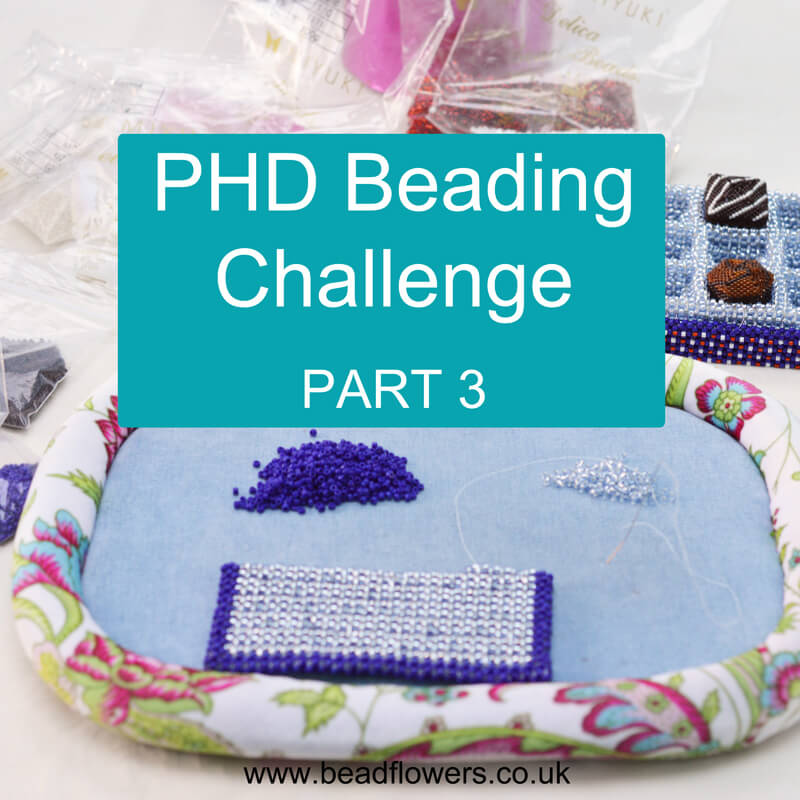
So, in part three of the PHD beading challenge, I’m going to be looking at how to make time for beading. Before we get into that, let’s just quickly recap on what you’ve (hopefully) been doing so far.
In part 1 (you can find the full blog post here), I helped you to begin bringing order to the chaos. By sorting your PHD projects into different categories, it is easier to prioritise which to clear first. That very simple act of organising things can begin to make a seemingly impossible task look achievable.
Then, in part 2, I asked you to begin tackling some of your ‘easy wins’. I also asked you to start sorting out a bead order to cover any projects for which you might have run out of materials. Again, if you want to follow all of that, you can find the full blog post here.
Most importantly, I also offered you the chance to join this Facebook group in order to get some moral support, and some (‘free beads’) incentives. These two things are really helpful in keeping you on track so you actually finish your PHDs this time.
But that still leaves us with one huge area that is problematic for most people. Time. The number one beading problem stated by most beaders is not being able to make time for beading. Or, more precisely, not making enough time for beading. So, what do you do to solve that one?
What stops you from making time for beading?
Now, I’m going to be totally up-front here. I haven’t invented a time machine. And I, like the rest of you, only have 24 hours in my day and 7 days in my week. I wish things could be different sometimes, but there we go.
However, if you’ve been following my work for any length of time, you’ve probably noticed that I’ve gained a reputation as a very prolific beader. In other words, I create an awful lot of beadwork!
Many people ask me if I forego sleep. In fact, quite the opposite. I probably sleep more hours than average. So, where does all my time magically come from?
Well, I began to answer that question by asking a different question…
What stops you from making time to bead?
Apart from the obvious (housework, your job, life in general), I think it mostly boils down to two things…
- your beading space
- your mindset
Happily, both these things are things that you can change pretty easily.
Your beading space – the problem of mess
If your beading space is either too cluttered or too tidy, this will get in the way of how much time you spend beading.
How so?
Well, a very cluttered or disorganised beading space means you’re taking up a lot of your beading time just trying to find things. So, when you’ve got that cheeky half hour for beading, you end up spending all of it looking for the beads and never actually stitching them together.
What’s the solution? Sort your space and sort your beading stash. That is a topic for another blog on another day. But if you do want some ideas for bead storage to help you get more organised, check out this link.
Your beading space – the problem of being too tidy?
How on earth can your beading space be too tidy?
Well, I’m thinking of those of you who clear everything away at the end of each beading session. Maybe you do this for a good reason (e.g., your beading space is also the dining room table and your family likes to eat!). Or maybe you simply do this out of habit. For example, you might not like seeing ‘clutter’ around.
But again, the very act of taking everything out and putting it all away again is taking up precious beading time. So, how do you fix that?
Well, I like to work on a large enough beading board that I can leave my project laid out at all times. So, the threaded needle, all the bags of beads, the instructions, and of course the project, are permanently sitting and waiting for me.
Naturally, this is an open invitation to spillages if you’re not careful. So, a good solution is to use an upturned lid as a bead board, then fasten the box belonging to the lid on top of it. At least then, if you (or someone else) does knock it all over, the mess will be contained inside!
I’ve actually covered this idea in a lot more detail in this link. So, you might want to check that out.

Your mindset
Oh no…she’s about to get all psychology-based on us here…
Not at all. What I’m getting at here is the issue of how you view your beadwork is going to have a huge impact on how much you get done.
Firstly, if you view it as a treat that is only to be done after you’ve completed all your ‘real jobs’, then the chances are it will never get done. Beadwork isn’t just a treat. If it’s something that brings you joy and relaxation, then it genuinely is a necessity for your health.
So, if you really want to look after your health, reduce your stress, etc., then make time for beading. Make it as important as brushing your teeth or eating a meal.
I’m not saying you’re going to be able to do it for eight hours a day every day. But you should start seeing it as a healthy daily activity in which to engage. Not just as a treat that may or may not happen from time to time.
So, I want you to actively set aside some time for beading EVERY DAY… Even if it’s just ten minutes, you’d be surprised how much you can achieve. And, if you followed my last tip and leave your project ready and waiting for you at all times, then you’ve only got to pop over to your beading board, and stitch a few rows.
Now, that brings me neatly to the other point about mindset…
One bead at a time
The second element of the mindset is how you approach your project when you actually sit down and bead. If you approach it from a place of stress, e.g., I’ve got SO MUCH to do and I’ll NEVER get it done, then of course you won’t get much beading done. You’re not setting yourself up in the right head-space to follow a tutorial or even enjoy the beading process.
Instead, start focusing on the ‘now’. Focus on each individual bead, each individual step. Enjoy that process and stop thinking about the finished result. I promise you, the work comes together MUCH faster that way. (Or it seems to, at least).
Even if you’re just spending ten minutes a day (and if you have your project laid out ready to go, you can do that), those ten minutes will bring you peace and see you make progress.
If you want to investigate that idea further, then this blog is another good read.
Your next challenge
So, now you’ve got a couple of ideas that will help you re-think your beading space and how you can use it efficiently, let’s look at moving on with those PHDs.
Of course, I want you to continue working your way through those ‘quick wins’.
I hope you have also managed to order any beads that you needed. So, this week, start focusing on the projects that had stalled because you ran out of beads.
We’re also going to take the first step to tackle your box of projects that stalled because you got stuck. I want you to pick out one or two of those and make a note of why you got stuck. Is it something that now makes sense simply because you’ve got more experience? Or is it a project for which you actually need to learn (or perfect) a new technique?
Click here to continue to the final installment. In that, I’m going to be taking you through some easy steps for learning new techniques.



